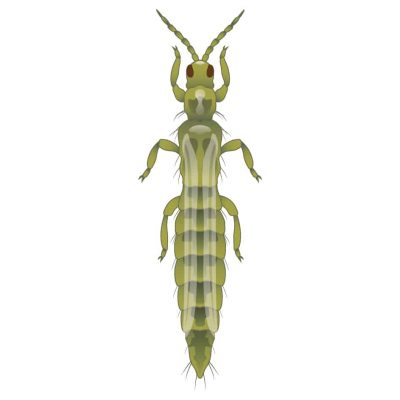Host plants
Western flower thrips is a polyphagous species with an extremely wide host plant range that includes more than 200 different plant species from more than 50 families, including table grapes. Guava thrips also has a wide host range and has been recorded from various indigenous and cultivated plants, including table grapes, persimmon, apple, plum, avocado, chrysanthemums and roses.
Damage
Feeding by western flower thrips larvae on the ovaries and developing grape berries during and just after flowering results in russe-like scarring. Egg-laying by western flower thrips females in ovaries and young berries causes so-called halo spot scarring, a light-coloured ring or halo around the oviposition site. In some of the summer rainfall regions where grapes are harvested very early in the season, feeding by larvae on shoots, young leaves and growth tips as the populations peak during summer causes severe scarring and stunted growth. Before western flower thrips became the dominant thrips species in vineyards, sporadic berry scarring as well as scarring and stunted growth of shoots by onion thrips, Thrips tabaci, had been reported on table grapes. Halo spot damage to grape berries due to egg-laying by western flower thrips tends to be sporadic, and economic losses are usually limited to periods of warm, dry weather which favour a rapid build-up of thrips populations early in spring. Shoot scarring and stunted growth due to feeding damage later in the season is a serious problem in many table grape growing areas in Mpumalanga, North West and Limpopo provinces, where grapes are harvested early in the growing season. Feeding by guava thrips, mostly on older leaves, causes silvering and sometimes russet-like scarring mainly on the underside of leaves. Droplets of reddish-brown fluid, produced with the excrement of larvae and adult guava thrips to deter predators, eventually turn black, and infested areas of leaves and fruit become spotted with characteristic black specks of faecal material. Guava thrips is less of a problem on table grapes than western flower thrips. Generally, populations peak in March and April and they only become abundant in vineyards towards the end of summer. By this time the grapes have already been harvested and any feeding damage to the leaves in not of economic importance.
Management
Vineyards with a history of western flower thrips damage should be monitored with the aid of blue sticky traps from before flowering. Traps should be sent to an expert for thrips identification before control decisions are made. Oviposition damage can occur even before flowers open, when contact insecticides are not very effective. Western flower thrips is known to develop resistance to pesticides very rapidly, which further limits the available control options. Weeds and other flowering plants in or near vineyards that also attract thrips should not be damaged or moved while the grapes are flowering, as this will result in masses of thrips migrating onto the vines or into the vineyards. Guava thrips generally do not cause economic damage and control is not required.





